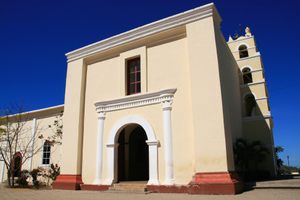
Todos Santos sits between the mountains and the sea. A small town known for its vibrant art communities, its ever-growing culinary scene, its surfing, and a spot called the Hotel California, which draws in fans of classic rock and mid-century architecture in equal measure. While Todos Santos has an exciting present, its history has long been a draw. This town was once known as Misión Santa Rosa de las Palmas, a Catholic mission founded in 1733.
Between 1720 and 1737, six such missions were established in the region, each with the purpose of converting the Indigenous populations to Christianity. The mission in what is now Todos Santos was founded by Jesuit missionaries who were drawn to the land, not just for the possibilities of “saving” souls, but because the land was rich in resources. Its fertile grounds would be perfect for farming and raising livestock. And it was near lots of accessible water sources. The abundance of the land could be seen in the lifestyle of the Guaycura, an Indigenous group that was living in the area before the Jesuits arrived. As researcher Robert H. Jackson explains, the Guaycuras were “hunter-gatherers who collected seeds, fruit, and shellfish along the coast and hunted small mammals and reptiles.” And due to government relocation, by 1768, there were around 800 Guaycura people living at the mission.
But the conversion attempts and the land grabs weren’t taken lightly. Warring factions of Guaycura often fought to reclaim the area. And as Jackson writes, they also “translated their disaffection into two forms of resistance: mass flight from the mission, and the theft or destruction of mission property.” This anger was only intensified by the recurring epidemics of diseases like measles and smallpox, which claimed hundreds of lives. By 1755, there were only 151 Guaycura left at the mission, most killed by disease and war. That number would drop to 82 by 1808. The mission was eventually shut down in 1825, but the area found a new life as hub of sugar production, with at least eight sugar mills in operation by the end of the 19th century. The sugar industry would boom until the 1950s, when the waters that had flowed for so long and given rise to the tiny town, suddenly dried up. The subsequent drought brought down the sugar prices, and effectively ended the sugar trade there.
The water returned in 1981, and Todos Santos began its next life with a return to agriculture. The road leading into the town was paved in 1984, opening it up to tourism. Along with the mission in the center of town announcing the history of Todos Santos, there are also remnants of the old sugar mills around town.
In 2006, Todos Santos was named a Pueblo Mágico by the Mexican government. Translating to Magical City, places with this designation (132 in total) are recognized for their history, symbolism, and an indefinable magic that seems to radiate from them. Though the history of Todos Santos is a complex, often difficult one, today its history and its present sit side by side, each informing the other on its vibrant streets and sparkling sea waters. Those timelines often intersect in October when the town celebrates the Virgin of Pilar festival, a five-day event when the plaza comes to life in celebration of the patron saint of Todos Santos.

Post a Comment